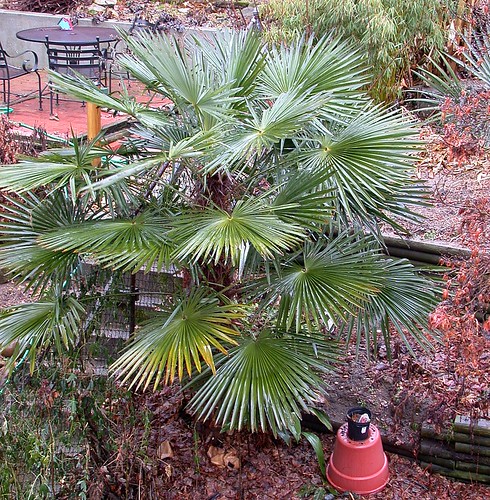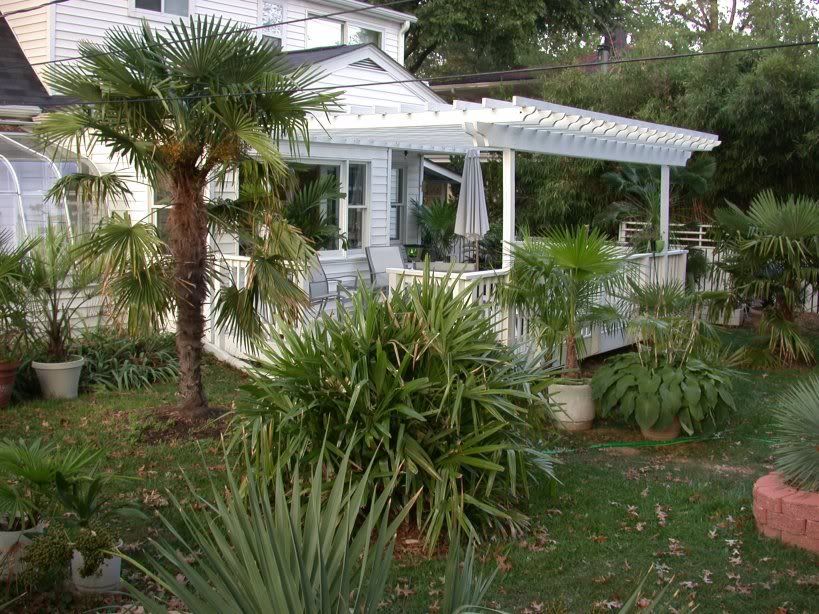
Garden at the end of January
When I give talks about growing hardy palms or other marginally hardy plants, one of my talking points is "location, location, location". My point is that I live in a city, so I benefit from an urban heat island that keeps me quite a bit warmer than the surrounding suburbs. In addition, there are microclimates within the city, and even within our own yards, that can add or subtract up to a half zone of hardiness. For example, my property is on a north-facing slope that receives no direct sun from mid-November to mid-January; overnight low temperatures in my yard are nearly always several degrees colder than the "official" temperatures for Washington, DC as recorded at Washington National Airport (which, ironically, is not even in DC!). This morning the official low at DCA was 16 degrees, but at 4:00 am the temperature in my yard was 12 degrees.
After this winter, my new talking point is going to be "duration, duration, duration." I wasn't terribly concerned about my low of 5 degrees in early January--with around 10 degrees the next night--because that event lasted just 2 nights and the day in between, with much warmer days on either side. My Trachycarpus wagnerianus took a hit from that, but my two larger windmill palms--T. fortunei "Nainital" and T. fortunei "Bulgarian"--looked great. Coming out of our third visit from the "polar vortex" this month, it's another story. The second and third cold waves haven't had such cold lows, but the two events came close together and it stayed cold for much longer, with repeated overnight lows just above or below 10 degrees and daytime temperatures remaining well below freezing. My palms look terrible.

Trachyarpus fortunei "Bulgarian", after the first cold wave but before the second and third
The urban heat island can only do so much. My winter lows are usually comparable to, and frequently higher than, those of warmer zones to the south like Raleigh, NC yet they can grow many plants there that we can't manage here. I think duration of cold--individual events and the winter in general--is one of the big differences. We also have those lows more frequently in any particular winter. I suspect most of my palms would have survived any one of the polar vortex events individually, but getting hit 3 times in one month is crippling.
The frequency of winters like this one is another factor. Plants that may survive a single such winter won't have a chance to recover enough to survive a second one. I saw this with two palmettos that were planted here in Washington, DC; they actually survived 2 winters, which was a huge surprise to me (see The saga of the Scottish Rite Palms). But the first winter hit them hard, they went into the second winter very weakened; one of them died shortly after the second winter and the second was probably doomed because they just couldn't re-grow in a single growing season the crown they had lost from the previous one. The lesson for me is that it may take more than one cold winter to kill a species like this, but that doesn't make it "hardy"; it's the frequency of such winters that is key. As long as cold winters are infrequent, the palm can recover and survive; but if back-to-back cold winters happen with any kind of frequency, the plant won't make it in the long term.
There are going to be a lot of dead palms in our area this spring. But with any luck, we'll have some survivors too. It's too soon to say whether my own palms will survive or not, and I've learned not to make predictions! But even if this winter wipes out every windmill palm in the Washington, DC area, I'll still be a fan of planting them. They can last 20 years here--especially if sited in a sheltered location--but luck definitely plays a big part in it. As long as people plant them with realistic expectations, understand and accept the risk, and are either willing to protect or can tolerate a certain amount of damage and ugliness in the spring (easier in a private garden than a public one), I still think they're worth growing here as an established palm will get through MOST winters with minimal damage.

Palmy yard in Arlington, Virginia

That's a very positive attitude and conclusion to your post John. Weather may be unpredictable year in year out but it's still worth rolling the dice.
ReplyDeleteThanks! I guess I'll know in a few weeks if they survived or not. Either way, I'll have a subject to blog about!
DeleteI love hearing all about your plants and thank you for sharing your knowledge!! I had started several palms and bananas it my yard in Falls Church, VA. I have since moved to the Bahamas but still wonder how my babies are doing up there!! Can't wait to see pics after the last two cold events!! I have my fingers crossed that they all make it!!! <3
ReplyDeleteThanks Audrey, I didn't realize you had moved to the Bahamas full-time. If you find out how the palms you left behind have done, let me know! This spring, a lot of us in the DC area will be comparing notes regarding which palms survived... or didn't!
DeleteI assume you didn't try to protect them or give supplemental heat via lights as many palm lovers do in your conditions? We may be losing marginals here in California from drought, and triage may be necessary to use limited water to keep favorites or best adapted palms and other non-drought tolerant plants alive. With regard to less cold tolerant palms, I plant far fewer Howea forsteriana and Archontophoenix cunninghamiana palms these days, both for drought and cold reasons. Butias, Braheas, various Trachycarpus spp, Chamaerops and Chamaedorea spp are all better for limited water supplies, or cold tolerance here. Chamaedorea spp aren't necessarily all more drought and cold tolerant, but their tolerance for more shade and smaller sizes makes them good under evergreen tree canopy where they're more protected and also often more drought tolerant than full sun plantings.
ReplyDeleteMy palms receive no protection other than mulch.
DeleteThanks John, I think we all needed a little dose of reality in terms of what our palms here in DC have been through and what our expectations should be. Although I cringe when I look at my palms out front, I need to remind myself that this is a hobby and hobbies have ups and downs. I'm certainly not going to give up on my large Trachy in the front yard until Summer. I've been with that plant for ten years and I'm loyal to the end. Dave Ray
ReplyDeleteI've been hoping for a "dose of reality" for a few years now, but not like this! I know what you mean about getting attached to our plants--I will be sorry to lose my T. wagnerianus as I grew it from a seed, and it has been in the ground almost exactly 10 years. But I'm not giving up on it yet!
DeleteWe still have the first 2 weeks of February. In N.J., February can pack a punch! I'm having variable results with Trachycarpus planted in sheltered sites. Two 'Bulgarias' are completely toasted. Others strains have minimal damage. Most are in between.
ReplyDeleteUgh, it's bad enough we had this weather, but to get it early in winter when there are still several weeks of cold weather left just makes it worse. This will be a very interesting spring for many of us...
Delete